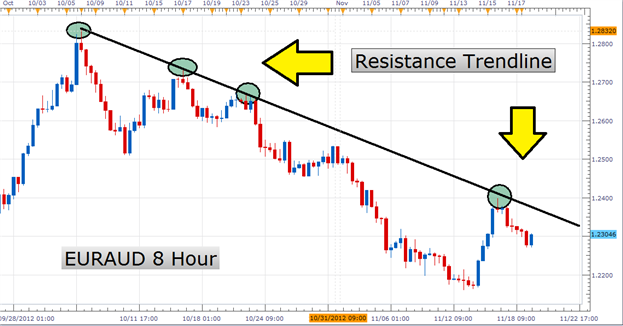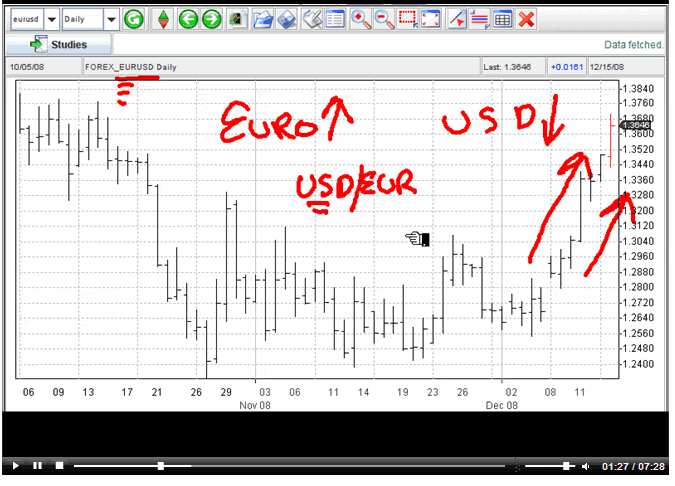How to Trade Forex
Post on: 5 Июнь, 2015 No Comment

One of the most liquid and widely traded markets in the world, forex trading enables you to speculate on the future direction of currencies through buying or selling the exchange rate of one country’s currency against another, with the aim of making a profit.
To Buy or to Sell?
Buying a currency pair, for example GBP/USD simply means that you buy the first currency in the pair (GBP) while simultaneously selling the second currency in the pair (USD) on expectations that the cross rate price will rise in value and your profits will rise in line with any increase in that price.
Conversely, selling a currency pair simply means that you sell the first currency in the pair (GBP) while simultaneously buying the second currency in the pair (USD) on expectations that the price will fall and your profits rise.
Forex Trading Example
Going Long on GBP/USD (Sterling/US Dollar)
It is the first Friday of the month and let’s assume that GBP/USD is currently trading at 1.6286/1.6288.
Traders are concerned about the employment situation in the US. They expect the level of actual non-farm payrolls to come in worse than economist estimates.
You expect that the US dollar will weaken and the British pound will strengthen against the US dollar, and decide to buy (go long) £10,000 on GBP/USD at 1.6288.
The trade size is in units of the first, or base, currency in the pair.
For this trade, you choose a leverage scale of 50:1. This requires an initial deposit of (£10,000*1.6288/50) $325.76. Find out more about Leverage.
As you anticipated, the pound strengthens against the dollar, and when it reaches 1.6350 you decide to cash in your profits. Our new price is 1.6350/1.6352 and you sell to close at 1.6350.
Result: You bought at 1.6288 and sold at 1.6350, a rise of 62 pips. This gives you a profit of:
(1.6350 – 1.6288) x 10,000 = $62.
Profit/Loss is calculated (and denominated) in the second, or counter currency of the pair.
Profit/Loss calculation: The difference between the closing price and opening price x size of trade.
Alternative scenario: If however, the actual non-farm payroll data had come in better-than-expected, the US dollar would have strengthened against the pound. If GBP/USD would have gone down, say, to 1.6230 you would lose (1.6288 1.6230) x 10,000 = $58.
Profit/Loss Conversion:
To help simplify the trading process, MidcoFX automatically converts trading P&L into the client’s denominated account currency at the prevailing market rate at the time that the trade is closed.
Going short on EUR/USD (Euro/US Dollar)
It is mid-July, and let’s say that EUR/USD is trading at 1.4360/1.4361.
Investors remain worried about the impact of the sovereign debt crisis and you expect the euro will fall against the US dollar. You decide to sell (go short) €10,000 on EUR/USD at 1.4360.
For this trade, you choose a leverage scale of 20:1. This requires an initial deposit of (€10,000*1.4360/20) $718.00.
You were right. Euro depreciates against the dollar to 1.4251 and you decide to close your trade and take your profits. Our new price is 1.4250/1.4251 and you buy to close at 1.4251.
Result: You sold at 1.4360 and bought at 1.4251, a fall of 109 pips, giving you a profit of:
(1.4360 1.4251) x 10,000 = $109.
Alternative scenario: If, however, a weaker dollar across the board overnight had pushed the euro up by 130 points to 1.4490, you would have lost (1.4490 – 1.4360) x 10,000 = $130.
Going long on USD/JPY (US dollar/Japanese Yen)
It is mid-March 2011 and USD/JPY is trading at 76.39/76.40.
The Japanese yen has surged since its worst earthquake in history due to high demand for yen as international businesses attempt to redevelop the devastated areas.
You believe that the yen is too strong and will fall back against the US dollar, ie the US dollar will strengthen against the yen. You decide to buy (go long) $10,000 on USD/JPY at 76.40.
For this trade, you choose a leverage scale of 25:1. This requires an initial deposit of ($10,000*76.40/25) 30,560 yen.
As you predicted, USD/ JPY bounces back to 78.66 and you decide to take your profits. Our new price is 78.66/ 78.68. You sell to close at 78.66.
Result: You bought at 76.40 and sold at 78.66, a rise of 226 pips, giving you a profit of:
(78.66 – 76.27) x 10,000 = 22600 yen.

Alternative scenario: If the dollar had continued to weaken against the yen, falling further to a record low of, say, 76.25, you would lose (76.40 – 76.25) x 10,000 = 1500 yen.
Going short on USD/CAD (US dollar/Canadian dollar)
It is mid-summer and let’s say USD/CAD is trading at 0.9520/0.9524.
A lack of progress in talks aimed at raising the US debt ceiling has weighed down on the US currency.
You expect USD/CAD will decline further and decide to sell (go short) $10,000 on USD/CAD at 0.9520.
You were right. The US dollar continues to weaken against the Canadian dollar and reaches a low of 0.9434. You decided to take your profits at this point. Our new price is 0.9430/0.9434 and you can therefore buy to close at 0.9434.
Result: You sold at 0.9520 and bought at 0.9434, a drop of 86 pips. This gives you a profit of:
(0.9520 – 0.9434) x 10,000 = CAD86.
Alternative scenario: If the dollar had bounced back against the Canadian dollar to 0.9600, you would have lost (0.9600 – 0.9520) x 10,000 = CAD80.
Going long on EUR/GBP (Euro/Sterling)
Let’s say EUR/GBP is trading at 0.8850/0.8852 at the moment.
Traders are bracing themselves for the worst, ahead of the release of UK Q2 GDP figures.
You expect the pound will depreciate against the euro, ie the euro will strengthen against the pound, and decide to buy (go long) €10,000 on EUR/GBP at 0.8852.
For this trade, you choose a leverage scale of 20:1. This requires an initial deposit of (€10,000*0.8852/20) £442.60.
As anticipated, the British pound goes down against the euro. EUR/GBP rises to 0.8880 and you decide to cash in your profits. Our new price is 0.8880/0.8882. You sell to close at 0.8880.
Result: You bought at 0.8852 and sold at 0.8880, an increase of 28 pips. This gives you a profit of:
(0.8880 – 0.8852) x 10,000 = £28.
Alternative scenario: The actual UK Q2 growth rate meets expectations, thus pushing the pound up against the euro. EUR/GBP declines to 0.8823. In this case, you would lose (0.8852 0.8823) x 10,000 = £29.














